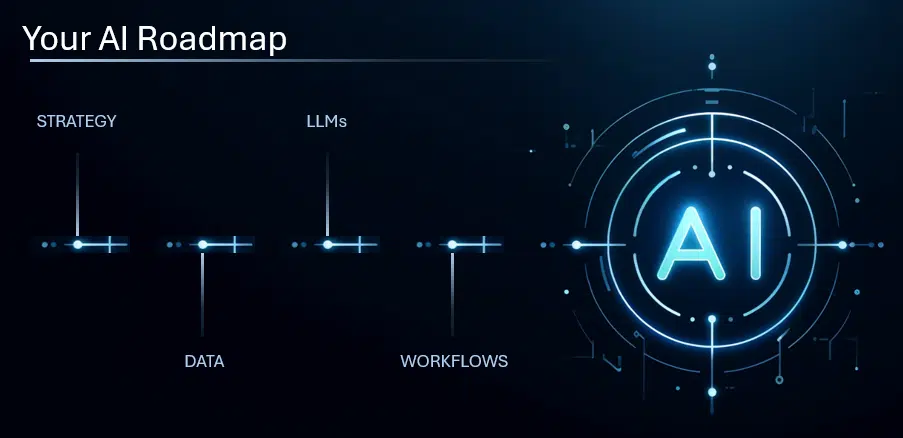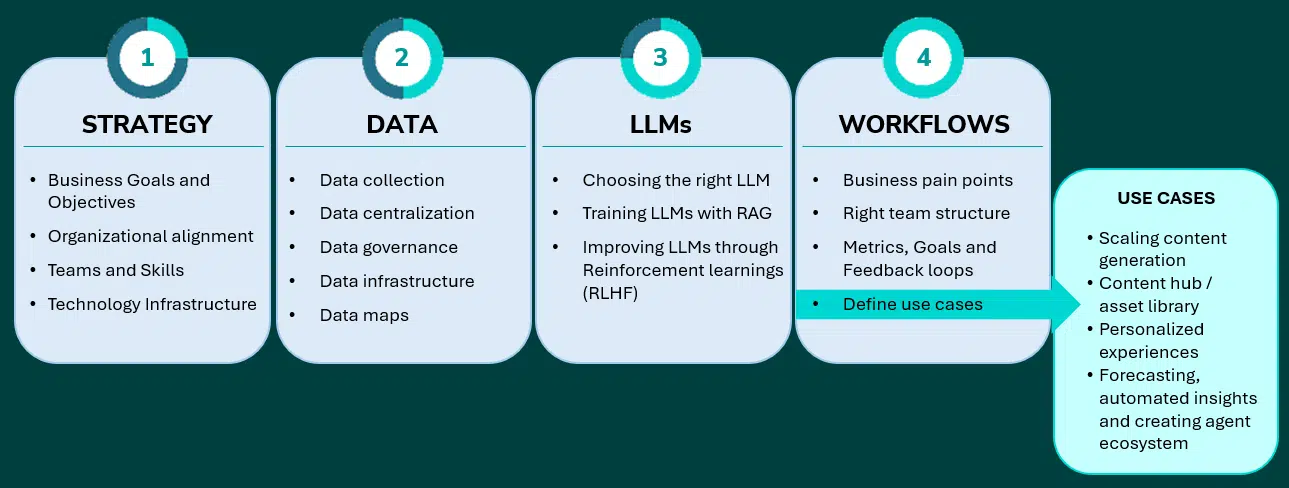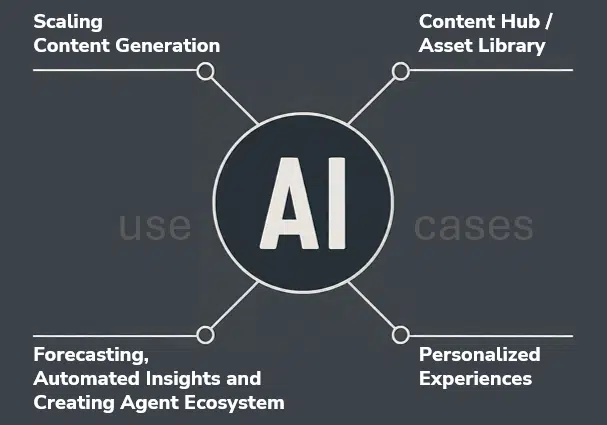#4 pillars of an effective enterprise AI strategy

Table of Contents
Learn how to build a strong AI roadmap by assessing your organization’s AI readiness and focusing on these key elements.
This involves carefully evaluating key factors such as data quality, technical expertise, organizational culture and ethical considerations related to AI adoption.
By building a comprehensive AI roadmap that accounts for the latest AI developments and their potential impact on search and content optimization, enterprises can ensure they are well-equipped to harness the transformative power of AI.
In this article, we will discuss four essential pillars for creating a solid AI roadmap and preparing enterprises for AI evolution.

Overcoming AI adoption hurdles in enterprises
Most enterprises are not fully prepared to embrace AI. They lack clear direction, policies, talent, knowledge, strategy and cloud execution due to a “fear of the unknown.”
Up to 76% of respondents said their organizations lack comprehensive AI policies, the Cisco AI Readiness Index found.
Achieving business objectives such as increased efficiency, growth and cost reduction through AI doesn’t happen overnight. It requires a well-curated strategy to transform into an AI-enabled organization that leverages AI to become better first, faster second and cheaper eventually.
4 pillars for creating a rock-solid AI roadmap


Broadly, there are four pillars for creating a rock-solid AI roadmap:
- Strategy
- Data
- Large language models (LLMs)
- Workflows
By focusing on these four pillars, organizations can build a rock-solid AI roadmap that drives meaningful improvements and creates a sustainable competitive advantage.
1. Strategy: Business objectives, goals and problems
The first pillar in creating an effective AI roadmap involves clearly defining your business objectives and goals. Begin by identifying specific friction/problem areas where AI can deliver tangible value and ensure outcomes are aligned with your overall business strategy.
This alignment ensures that your AI initiatives are in sync with the broader strategic vision of the organization. AI won’t reduce costs from day one.
By identifying business goals, potential problems, relevant use cases, necessary teams, required skills and the technological infrastructure needed, you can better define the scope of your AI initiatives.
2. Data
Clean, high-quality data is critical for creating your organization’s AI roadmap. Ensuring you have high-quality, relevant data and the necessary infrastructure to collect, store and process this data effectively is paramount.
AI models, especially LLMs, rely heavily on your organization’s data. However, issues like data hallucination can occur with LLMs, making it critical that your data is secure, clean and readily available.
Below are the five steps to ensure a comprehensive data strategy:


Data collection
- Identify and inventory the data sources crucial for AI initiatives.
Data centralization
- This means gathering data from different sources within the organization and storing it in one central location.
- This central repository can be used to train and deploy AI models.
- Centralizing data improves quality, availability, collaboration, and governance.
Data governance
- This is essential for setting clear policies on data quality, privacy, security and reliability.
- Organizational policies should ensure transparency and compliance with global standards like GDPR and cookie policies.
- Protecting proprietary data used to train LLMs is crucial, ensuring it isn’t shared publicly or across departments.
- For example, if HR uses an LLM to create confidential documents, employees shouldn’t access this data using the same LLM.
- Enterprises must follow best practices for responsible AI, enforcing privacy and security in both data and the models trained on it.
Data infrastructure
- Set up scalable and secure data storage solutions to handle growing data needs.
Data maps
- Create comprehensive data maps to understand data flow and relationships across the organization.
By meticulously planning your data strategy, you can lay a strong foundation for your organization’s AI endeavors and mitigate risks associated with data-related challenges.
3. LLMs: How to make them work for enterprises
LLMs have become a cornerstone of many AI applications, enhancing capabilities in natural language understanding, generation and complex decision-making processes.
Trained in billions of parameters, LLMs can be incredibly powerful tools for problem-solving. For businesses, it’s crucial to choose the right LLMs, train them with accurate data and create feedback loops to constantly improve these models.
There are two main types of LLMs: open-source and closed-source.
Open-source models
- Models such as Llama, OPT-IML, GLM, UL2 and Galactic are accessible to everyone.
- They can be customized and fine-tuned for specific tasks, offering cost advantages, rapid innovation and customization options.
- However, they require significant in-house expertise and management.
Closed-source models
- In contrast, closed-source models do not have publicly available source codes. Developed and maintained by organizations or companies, these models remain proprietary.
- Examples include OpenAI’s GPT-4, Google Bard, Gemini 1.5, Claude and Cohere. These models are typically trained through supervised learning on large datasets and reinforcement learning using both human and AI feedback.
- These models provide predictability, support and ease of use, though at a higher cost. This makes them more suitable for enterprises seeking reliable and ready-to-use AI solutions.
When selecting an LLM, organizations must consider their maturity, in-house skills and data strategy.
- Open-source models offer flexibility and innovation advantages but require significant management.
- Closed-source models, while more costly, offer robust support and ease of use, making them ideal for companies looking for dependable AI solutions without the need for extensive internal resources.
Training LLMs
Training LLMs effectively involves using both publicly available data and organization-specific data. Two key techniques for training LLMs are retrieval-augmented generation (RAG) and reinforcement learning from human feedback (RLHF).
Retrieval-augmented generation
- RAG involves analyzing a large amount of organizational data to identify important pieces of content, which are then supplied to the language model as context.
- This approach addresses the limitations of LLMs by fetching contextually relevant information from additional resources, enhancing the model’s performance and accuracy.
Reinforcement learning from human feedback
- RLHF combines reinforcement learning techniques with human guidance to ensure that LLMs deliver relevant and high-quality results.
- By incorporating human feedback into the learning process, LLMs can continuously improve and generate more accurate and contextually appropriate responses.
Choosing the right models for you
Consider using well-known models based on your organization’s use cases and applications. For instance:
- Claude 3 by Anthropic: Ideal for content-related tasks.
- DALL-E by OpenAI: Optimal for generating and processing images.
- Google Gemini: Known for efficient search agent capabilities.
- Meta Llama 3: Specialized in code-based operations and automation tasks.
4. Workflows
The most critical step is identifying suitable workflows and use cases where AI can seamlessly integrate into your existing operations.
Once business objectives, data strategy and LLM integration are established, the next step involves developing AI-driven workflows that automate and optimize processes within your organization’s operational framework.
Here is a structured approach to consider:
Identify business pain points and align these with business goals and offerings
Start by pinpointing the areas in your business that need improvement and align these pain points with your strategic goals and product or service offerings.
Establish clear use cases with organization gaps
Define specific use cases where AI can add value and identify any current gaps in your processes that AI could fill. Here are a few use cases to consider:


- Scale content generation
- Use AI to generate personalized, entity-rich topical content and measure the quality and relevancy of generated content.
- Futureproof your digital presence by creating a content hub or asset library
- Centralize all your critical content in a content hub, including articles, PDFs, images and videos to avoid creating multiple copies of the same content. Once centralized, use AI to measure the quality and relevancy of all images using LLMs.
- Personalizing experiences
- Use AI to create personalized customer and prospect experiences, recommend products and improve marketing campaigns.
- Forecasting
- Organic traffic forecasting predicts the future number of site visitors from unpaid search results. This uses historical data, seasonality, trends and machine learning to generate accurate predictions.
- By forecasting traffic, you can plan strategies, allocate resources and set realistic targets.
- This helps optimize content, SEO efforts and campaign timing to boost engagement and conversions.
- Accurate forecasts identify potential issues early, allowing for proactive adjustments to maintain or improve search rankings and website performance.
- Automated insights
- Apply AI to unlock insights from large datasets, enabling data-driven decision-making and business strategy optimization.
- Generative AI can provide real-time, actionable insights by processing data from various sources, enabling businesses to make informed decisions quickly.
- LLMs can be fine-tuned with your organization’s data to provide strategic recommendations.
- Creating agent ecosystem
- AI will evolve into agents that make decisions and take actions on their own.
- While AI will still generate text, images and insights, these agents will use this information to act independently and not just advise humans.
- Enterprises should explore how well-structured data can be used to create these agents for various use cases, such as support, marketing and customer success teams.
Identify the right team structure
Successful AI deployment typically requires a cross-functional team. Identify the necessary resources, infrastructure and skills and address gaps to form an effective team.
The skills required from SEO professionals, digital marketers, content writers and coders have evolved.
Team members must evolve and learn how machine learning works, including prompt engineering, developing a deep understanding of customer problems and acquiring organizational alignment and enablement skills.
Define metrics, goals and feedback loops
Set clear metrics and goals to measure the success of your AI initiatives. Establish feedback loops to continuously monitor and improve the AI workflows.
Big Tech’s mad rush to deploy AI across all offerings
Google, Apple, Amazon and Meta have released robust roadmaps for bringing AI across all offerings.
Google’s I/O 2024 showcased a diverse range of AI innovations to enhance user experiences across various domains and applications, including AI-powered search enhancement, AI in productivity tools, various healthcare applications, smart homes innovations, developer tools and security and sustainability applications.
These announcements highlight Google’s commitment to leveraging AI to solve complex problems and improve daily lives.
Enterprises need to decide if they want to be AI-first vs. AI-enabled
Organizations must decide whether they want to be AI-first or AI-enabled.
AI-first companies are in the business of advancing AI as a science, whereas AI-enabled companies are implementation and distribution machines.
AI-first companies innovate just above hardware, whereas AI-enabled companies create enterprise value at the application level.
For AI to truly flourish, achieving alignment across your organization becomes critical.
This means fostering a cultural shift where everyone feels empowered to identify business problems and workflows ready for automation. Collaboration across all teams is essential to achieve this.
AI unleashes the next level of human potential
Organizations must develop an AI roadmap to assess their readiness and effectively leverage AI technology. This roadmap should focus on five key areas: strategy, data, LLMs and workflows.
The goal is to create a future-proof AI strategy that transforms the organization into an AI-driven powerhouse with competitive advantages. By taking this comprehensive approach, you can unlock the transformative potential of AI, amplify human capabilities and drive lasting positive impact.
If you liked the article, do not forget to share it with your friends. Follow us on Google News too, click on the star and choose us from your favorites.
If you want to read more like this article, you can visit our Technology category.




